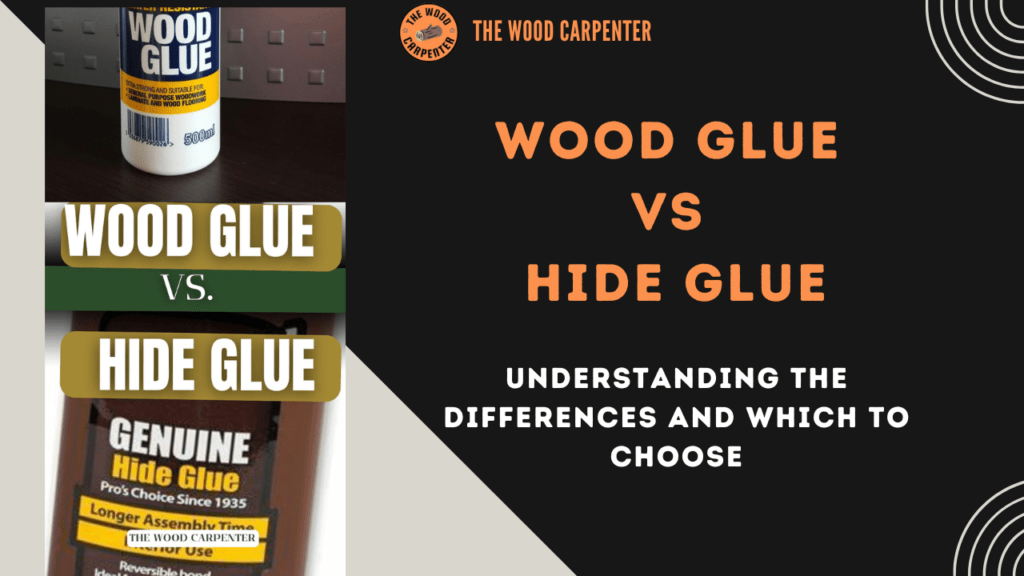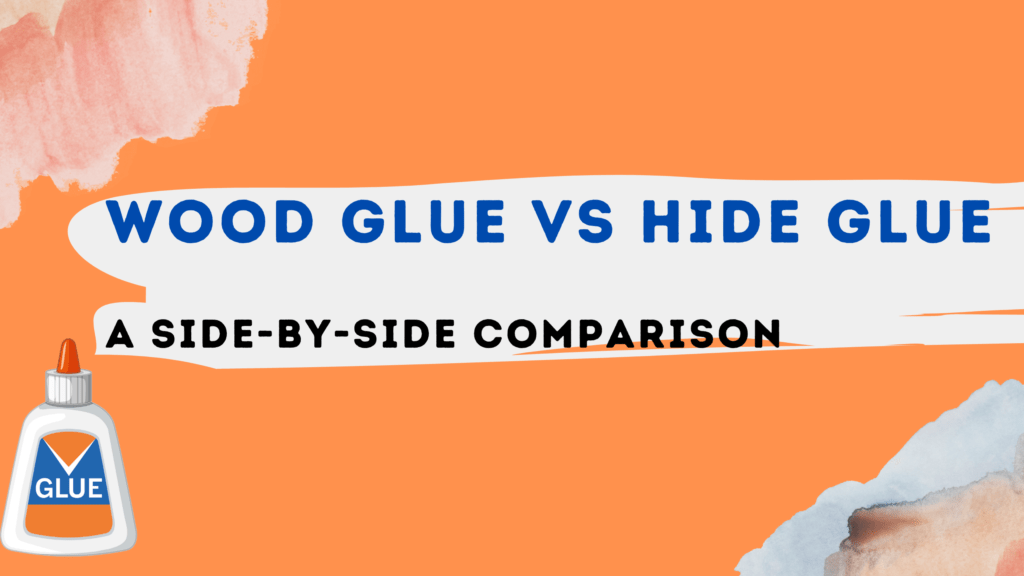
When you’re building or fixing wooden furniture, choosing the right glue is very important. The right glue keeps your project strong and helps it last a long time. Two common types of glue used in woodworking are wood glue and hide glue. While both are made for sticking pieces of wood together, they work in different ways and have their own pros and cons.
In this guide, we’ll explain what wood glue and hide glue are, how they work, and which one might be the best fit for your project.
What Are Wood Glue and Hide Glue?
Both of these glues are used to stick wood pieces together, but they are made from different materials and have different features:
Wood Glue (often called PVA glue) is a modern, synthetic glue made in factories. It’s strong, easy to use, and great for most woodworking jobs.
Hide Glue is a traditional, natural glue made from animal parts like skin and bones. It’s been used for hundreds of years, especially for fine furniture and musical instruments.
By learning how each glue works, you’ll be able to choose the one that suits your project best.
Key Characteristics of Wood Glue
Strong Bonding: Wood glue penetrates deeply into wood fibers, creating a durable and long-lasting bond.
Versatility: It can be used on various materials besides wood, including paper, fabric, and some plastics.
Ease of Application: Wood glue is user-friendly, with a low viscosity that allows for precise application and easy cleanup with water.
Fast Drying: Many wood glues, such as Titebond II and III, dry within an hour or two under normal conditions, speeding up project completion.
Water Resistance: Some wood glues are formulated for exterior use, offering enhanced water and weather resistance.
Wide Availability: Wood glue is readily available at hardware stores and online retailers.
Types of Wood Glue
Before we compare wood glue with hide glue, let’s look at the different types of wood glues you might use. Not all glues work the same, and each one is better for certain kinds of jobs.
1. PVA Wood Glue
- PVA stands for Polyvinyl Acetate. It’s the most common wood glue.
- Looks white when wet, but dries clear
- Great for furniture, cabinets, and other indoor projects
- Easy to use, dries fairly quickly, and creates a strong hold
2. Polyurethane Wood Glue
- This glue is stronger and more water-resistant than PVA.
- Good for outdoor projects, where water or weather might be a problem
- Usually has a yellow-brown color
- Bonds very tightly but may foam and expand, so cleanup can be tricky
3. Epoxy Wood Glue
- Epoxy is a two-part glue (resin + hardener) that forms a very strong and long-lasting bond.
- Best for heavy-duty work like boat building, furniture repair, or cracked wood
- Works well even if the surfaces don’t fit perfectly
- Takes longer to apply and dry, but gives excellent strength.
Limitations of Wood Glue
Permanent Bond: Once cured, wood glue is difficult to remove without damaging the wood.
Swelling Wood Fibers: PVA glue can cause wood fibers to swell, making tight joints harder to assemble.
Stain Penetration: Wood glue can fill wood pores, leading to uneven stain absorption if not cleaned properly before finishing.
What Is Hide Glue?
Hide glue, also called animal glue, is a natural type of glue made from animal parts. It comes from collagen, which is found in the skin, bones, and other tissues of animals—usually cows or pigs. To make the glue, these parts are boiled to pull out the collagen, which turns into a sticky substance used to join pieces of wood.
A Brief History of Hide Glue
Hide glue has been used for thousands of years. Long ago, people used it to build furniture, musical instruments (especially violins and other string instruments), and even in old-style home decorations. It was the main glue woodworkers used before modern glues were invented. Craftsmen liked it because it was strong, long-lasting, and gentle enough for delicate work.
Key Characteristics of Hide Glue
Natural and Eco-Friendly: Derived from animal hides, hide glue is biodegradable and FDA-approved for indirect food contact.
Reversibility: Hide glue can be softened or dissolved with heat and moisture, making it ideal for repairs and restorations.
Elasticity: Even when fully cured, hide glue maintains some elasticity, allowing wood to expand and contract without creep.
No Fiber Swelling: Hide glue does not cause wood fibers to swell, making it suitable for tightly fitted joints.
Long Open Time: Hide glue offers a longer working time compared to many synthetic adhesives.
Compatibility with Stains: It does not interfere with wood stain penetration, resulting in a more even finish.
Limitations of Hide Glue
Preparation Required: Hot hide glue must be prepared by mixing granules with water and heating, which can be time-consuming.
Odor: Hide glue has a distinctive smell during application, though it dissipates as it dries.
Shorter Shelf Life: Liquid hide glue typically has a shelf life of about 24 months, and dry hide glue can degrade if not stored properly.
Not Water Resistant: Hide glue is not suitable for outdoor or high-moisture environments
Also read:
Water Stains on Wood: 6 Step-by-Step Tricks to remove it
Stain vs Varnish which should you choose
Oil-Based Stain vs Water-Based Stain: Which One Should You Choose?
Advantages and Disadvantages of Wood Glue & Hide Glue
Wood Glue
Advantages:
- Strong, permanent bond
- Fast drying
- Easy to apply and clean up
- Versatile for many materials
- Widely available and affordable
Disadvantages:
- Difficult to remove once cured
- Can cause wood fiber swelling
- May affect stain absorption
- Not always suitable for repairs requiring disassembly
Hide Glue
Advantages:
- Reversible with heat and moisture
- Natural and eco-friendly
- Does not swell wood fibers
- Excellent for repairs and restorations
- Compatible with wood stains
Disadvantages:
- Requires preparation (hot hide glue)
- Shorter shelf life
- Not water resistant
- More expensive
- Distinctive odor during application
Which Glue Should You Use?
Choosing between wood glue and hide glue depends on your project requirements and priorities.
Use Wood Glue (PVA) if:
- You need a strong, permanent bond.
- Your project requires fast assembly and drying.
- You are working on general woodworking, furniture, or repairs.
- You need a water-resistant adhesive for outdoor use (choose a waterproof formula).
Use Hide Glue if:
- You are restoring or repairing antique furniture.
- You need a reversible adhesive for future repairs or adjustments.
- You are building or repairing musical instruments.
- You require a glue that does not affect wood stain penetration.
- You value eco-friendliness and natural materials.
Wood Glue vs Hide Glue: A Side-by-Side Comparison

| Feature | Wood Glue (PVA) | Hide Glue |
| Composition | Synthetic (polyvinyl acetate) | Animal collagen |
| Strength | Very strong, permanent | Strong, flexible, reversible |
| Drying Time | Fast (1–2 hours) | Slower, longer open time |
| Preparation | Ready to use | Requires heating (hot hide) |
| Reversibility | Difficult to remove | Easily reversible with heat |
| Water Resistance | Some formulas are water-resistant | Not water resistant |
| Wood Fiber Swelling | Can cause swelling | Does not cause swelling |
| Stain Compatibility | Can affect stain penetration | Compatible, even stain finish |
| Odor | Mild, usually unnoticeable | Noticeable, dissipates |
| Shelf Life | Long | 24 months (liquid) |
| Eco-Friendliness | Moderate | High (natural, biodegradable) |
| Cost | Affordable | More expensive |
Expert Tips for Using Wood Glue and Hide Glue
For Wood Glue:
- Always clamp glued pieces until the adhesive is fully cured for the strongest bond.
- Clean excess glue with a damp cloth before it dries to avoid staining.
- Choose a waterproof formula for outdoor projects.
For Hide Glue:
- Prepare hot hide glue by heating it to the recommended temperature (usually around 145°F or 63°C) for best results.
- Use a double boiler to avoid scorching the glue.
- Work in a well-ventilated area to minimize odor exposure.
Frequently Asked Questions (FAQs)
Can I use hide glue for general woodworking?
Yes, but it’s more commonly used for fine woodworking and restoration projects due to its reversibility.
Is wood glue stronger than hide glue?
While wood glue is very strong, hide glue can offer a unique bond, especially for delicate or antique wood.
Can hide glue be used on outdoor projects?
Hide glue is not ideal for outdoor use, as it does not provide the moisture resistance of polyurethane or epoxy wood glues.
How long does hide glue take to dry?
Hide glue typically requires a longer drying time compared to modern wood glues, with some types needing up to 24 hours to fully cure.
Can wood glue be removed after it dries?
No, wood glue, once dried, is permanent and cannot be easily undone.
Conclusion
Wood glue is great for most everyday projects because it’s easy to use and strong, while hide glue is ideal for fine woodworking and restoration work due to its unique properties.

